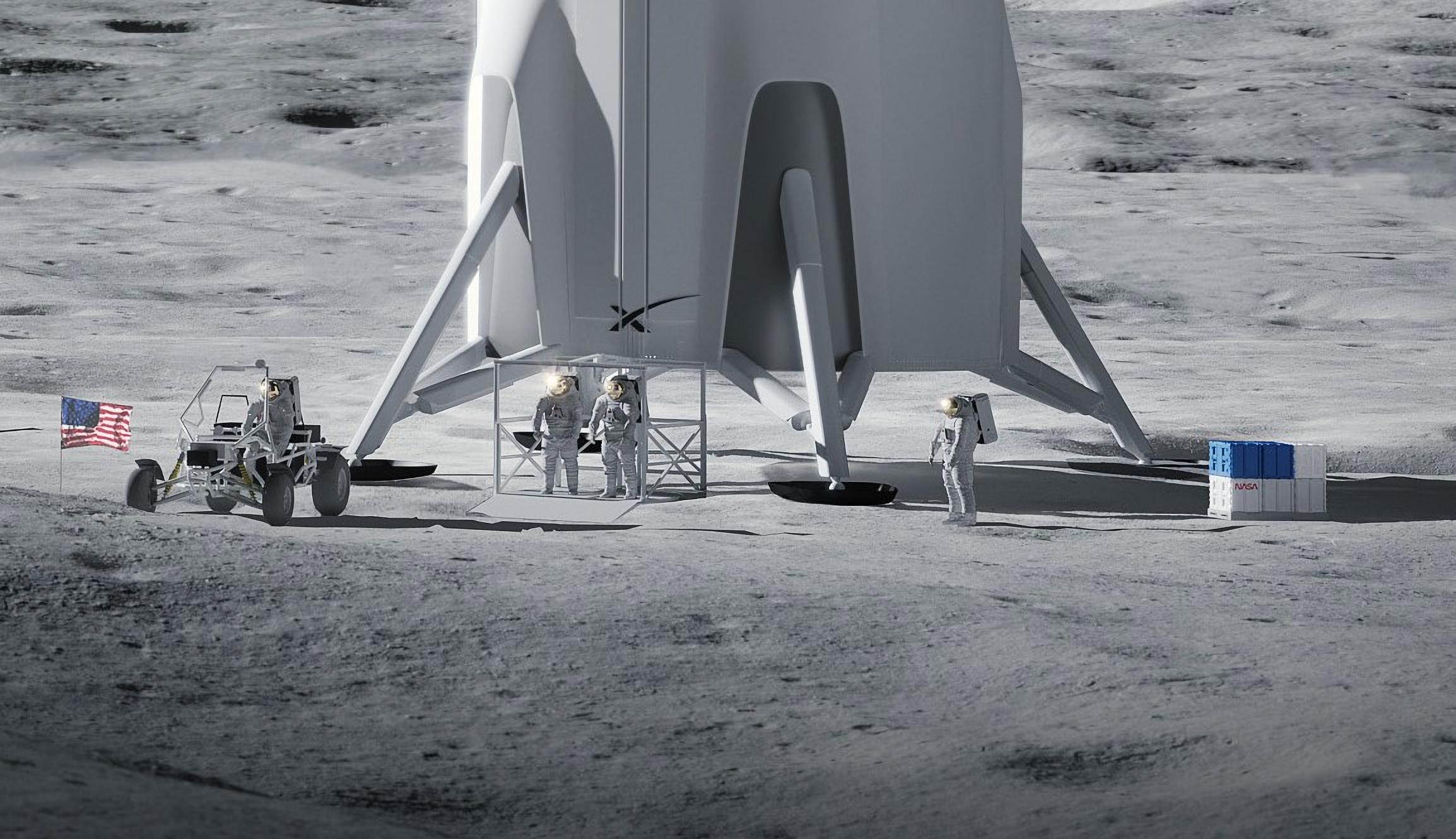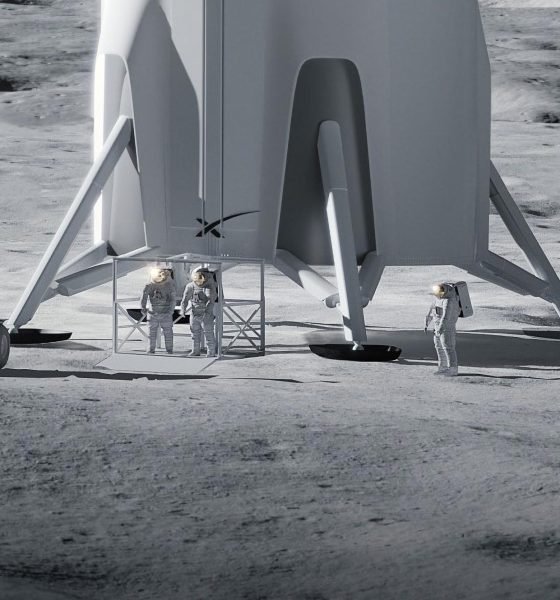

News
Elon Musk says SpaceX could build new Moon spacesuits for NASA
A new report from NASA’s Office of the Inspector General (OIG) strongly suggests that spacesuit availability, of all things, could prevent NASA from returning humans to the Moon on schedule in 2024.
Days prior, a similar watchdog office (GAO) denied protests from Blue Origin and Dynetics that were preventing NASA and SpaceX from working on the Starship-derived lander that will land those same humans on the Moon. Now, in an indirect response to NASA OIG’s analysis of the status of NASA’s next-generation spacesuit procurement efforts, CEO Elon Musk says that SpaceX may be able to provide its own custom Moon-rated spacesuits on top of a Starship lander.
As it turns out, SpaceX is already one of around two dozen “interested parties” [PDF] active in NASA’s new xEVAS (Exploration Extravehicular Activity Services) program – an effort to commandeer the spectacular success of commercial cargo and crew programs to replace half-century-old spacesuits. xEVAS has currently released a draft Request for Proposal (RFP) and is awaiting responses to that draft until mid-August before releasing the true RFP in mid-September.
Interested parties will then have until mid-October to submit proposals to design and build modern EVA (extravehicular activity) spacesuits capable of supporting astronauts on the lunar surface and on spacewalks in Earth orbit. NASA says it will then take a full five (or seven) months to review those proposals, downselect, and reward at least one or two contracts – hopefully resulting in two redundant EVA systems much like the 2+ redundant providers NASA chose to support its Commercial Crew (CCP) and Cargo Resupply Services (CRS) programs.
Over the last decade and a half, NASA has been very gradually working on its own next-generation EVA suits. Known as “xEMU,” the program has been less than smooth, running into multiple issues, funding shortfalls, and delays over the years. NASA OIG’s August 10th, 2021 report [PDF] says that the minimum two xEMU suits needed to support a planned crewed Moon landing as early as 2024 are almost certainly not going to be ready by 2024 after COVID-19, funding shortfalls, and technical difficulties recently delayed the program by almost two years. The office estimates that those NASA-built EVA suits will be ready absolutely no earlier than April 2025.
However, in April 2021, NASA kicked off its brand new xEVAS program – a program that strongly implies that the agency is all but giving up on building its own xEMU EVA suits. While it appears that the agency still plans to build six of its own xEMU suits as a hedge against its innovative, unprecedented xEVAS EVA-suits-as-a-service program, there’s a chance that NASA’s prospective commercial providers could help mitigate or outright prevent spacesuit availability from delaying humanity’s return to the Moon.
Of course, with NASA set to award xEVAS contracts no earlier than either March or May 2022, providers would be left with a mere ~30 months to design, prototype, build, and qualify what amount to personal human-rated spacecraft (EVA suits). According to NASA, “the goal is to achieve one or more EVA service demonstrations as early as 2024, and the full suite of commercial EVA services beginning as soon as feasible thereafter” – an extraordinarily ambitious target.
Notably, for its spectacularly successful Crew Dragon program, SpaceX has already developed and repeatedly flown a custom pressure suit for Dragon astronauts. That IVA suit is designed to keep astronauts alive in the event of spacecraft depressurization. Due to the mobility they must provide and a resultant need for light and portable power and life support systems, EVA suits are dramatically more complex than IVA suits, which offer very little mobility when fully pressurized and are permanently connected to their spacecraft through umbilicals.
If anyone can rise to the challenge of developing an EVA suit from scratch in two years, though, it’s likely SpaceX.

News
Tesla FSD fleet is nearing 7 billion total miles, including 2.5 billion city miles
As can be seen on Tesla’s official FSD webpage, vehicles equipped with the system have now navigated over 6.99 billion miles.

Tesla’s Full Self-Driving (Supervised) fleet is closing in on almost 7 billion total miles driven, as per data posted by the company on its official FSD webpage.
These figures hint at the massive scale of data fueling Tesla’s rapid FSD improvements, which have been quite notable as of late.
FSD mileage milestones
As can be seen on Tesla’s official FSD webpage, vehicles equipped with the system have now navigated over 6.99 billion miles. Tesla owner and avid FSD tester Whole Mars Catalog also shared a screenshot indicating that from the nearly 7 billion miles traveled by the FSD fleet, more than 2.5 billion miles were driven inside cities.
City miles are particularly valuable for complex urban scenarios like unprotected turns, pedestrian interactions, and traffic lights. This is also the difference-maker for FSD, as only complex solutions, such as Waymo’s self-driving taxis, operate similarly on inner-city streets. And even then, incidents such as the San Francisco blackouts have proven challenging for sensor-rich vehicles like Waymos.
Tesla’s data edge
Tesla has a number of advantages in the autonomous vehicle sector, one of which is the size of its fleet and the number of vehicles training FSD on real-world roads. Tesla’s nearly 7 billion FSD miles then allow the company to roll out updates that make its vehicles behave like they are being driven by experienced drivers, even if they are operating on their own.
So notable are Tesla’s improvements to FSD that NVIDIA Director of Robotics Jim Fan, after experiencing FSD v14, noted that the system is the first AI that passes what he described as a “Physical Turing Test.”
“Despite knowing exactly how robot learning works, I still find it magical watching the steering wheel turn by itself. First it feels surreal, next it becomes routine. Then, like the smartphone, taking it away actively hurts. This is how humanity gets rewired and glued to god-like technologies,” Fan wrote in a post on X.
News
Tesla starts showing how FSD will change lives in Europe
Local officials tested the system on narrow country roads and were impressed by FSD’s smooth, human-like driving, with some calling the service a game-changer for everyday life in areas that are far from urban centers.

Tesla has launched Europe’s first public shuttle service using Full Self-Driving (Supervised) in the rural Eifelkreis Bitburg-Prüm region of Germany, demonstrating how the technology can restore independence and mobility for people who struggle with limited transport options.
Local officials tested the system on narrow country roads and were impressed by FSD’s smooth, human-like driving, with some calling the service a game-changer for everyday life in areas that are far from urban centers.
Officials see real impact on rural residents
Arzfeld Mayor Johannes Kuhl and District Administrator Andreas Kruppert personally tested the Tesla shuttle service. This allowed them to see just how well FSD navigated winding lanes and rural roads confidently. Kruppert said, “Autonomous driving sounds like science fiction to many, but we simply see here that it works totally well in rural regions too.” Kuhl, for his part, also noted that FSD “feels like a very experienced driver.”
The pilot complements the area’s “Citizen Bus” program, which provides on-demand rides for elderly residents who can no longer drive themselves. Tesla Europe shared a video of a demonstration of the service, highlighting how FSD gives people their freedom back, even in places where public transport is not as prevalent.
What the Ministry for Economic Affairs and Transport says
Rhineland-Palatinate’s Minister Daniela Schmitt supported the project, praising the collaboration that made this “first of its kind in Europe” possible. As per the ministry, the rural rollout for the service shows FSD’s potential beyond major cities, and it delivers tangible benefits like grocery runs, doctor visits, and social connections for isolated residents.
“Reliable and flexible mobility is especially vital in rural areas. With the launch of a shuttle service using self-driving vehicles (FSD supervised) by Tesla in the Eifelkreis Bitburg-Prüm, an innovative pilot project is now getting underway that complements local community bus services. It is the first project of its kind in Europe.
“The result is a real gain for rural mobility: greater accessibility, more flexibility and tangible benefits for everyday life. A strong signal for innovation, cooperation and future-oriented mobility beyond urban centers,” the ministry wrote in a LinkedIn post.
News
Tesla China quietly posts Robotaxi-related job listing
Tesla China is currently seeking a Low Voltage Electrical Engineer to work on circuit board design for the company’s autonomous vehicles.

Tesla has posted a new job listing in Shanghai explicitly tied to its Robotaxi program, fueling speculation that the company is preparing to launch its dedicated autonomous ride-hailing service in China.
As noted in the listing, Tesla China is currently seeking a Low Voltage Electrical Engineer to work on circuit board design for the company’s autonomous vehicles.
Robotaxi-specific role
The listing, which was shared on social media platform X by industry watcher @tslaming, suggested that Tesla China is looking to fill the role urgently. The job listing itself specifically mentions that the person hired for the role will be working on the Low Voltage Hardware team, which would design the circuit boards that would serve as the nervous system of the Robotaxi.
Key tasks for the role, as indicated in the job listing, include collaboration with PCB layout, firmware, mechanical, program management, and validation teams, among other responsibilities. The role is based in Shanghai.
China Robotaxi launch
China represents a massive potential market for robotaxis, with its dense urban centers and supportive policies in select cities. Tesla has limited permission to roll out FSD in the country, though despite this, its vehicles have been hailed as among the best in the market when it comes to autonomous features. So far, at least, it appears that China supports Tesla’s FSD and Robotaxi rollout.
This was hinted at in November, when Tesla brought the Cybercab to the 8th China International Import Expo (CIIE) in Shanghai, marking the first time that the autonomous two-seater was brought to the Asia-Pacific region. The vehicle, despite not having a release date in China, received a significant amount of interest among the event’s attendees.








